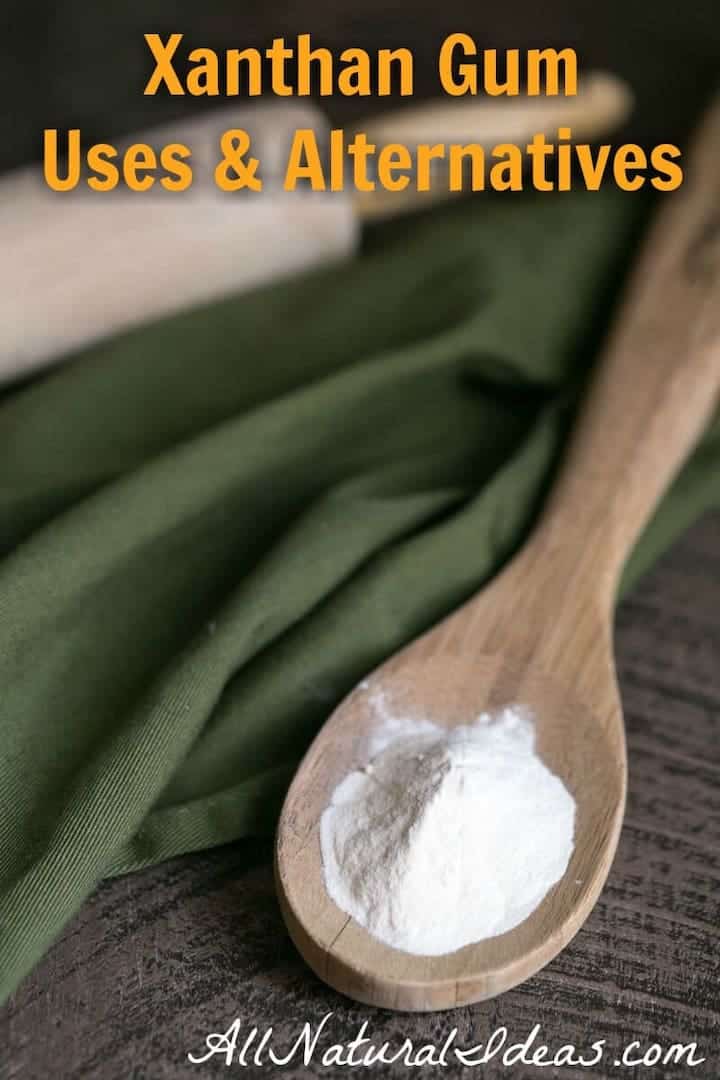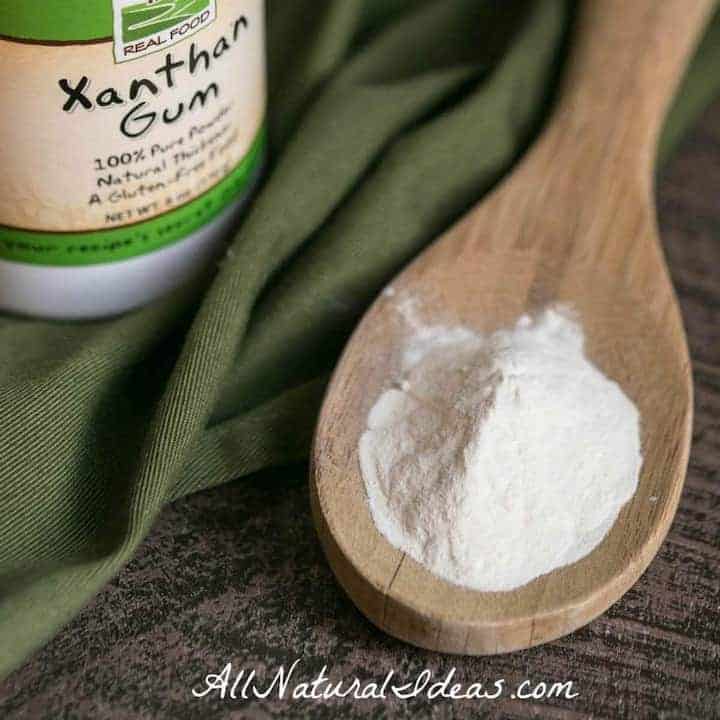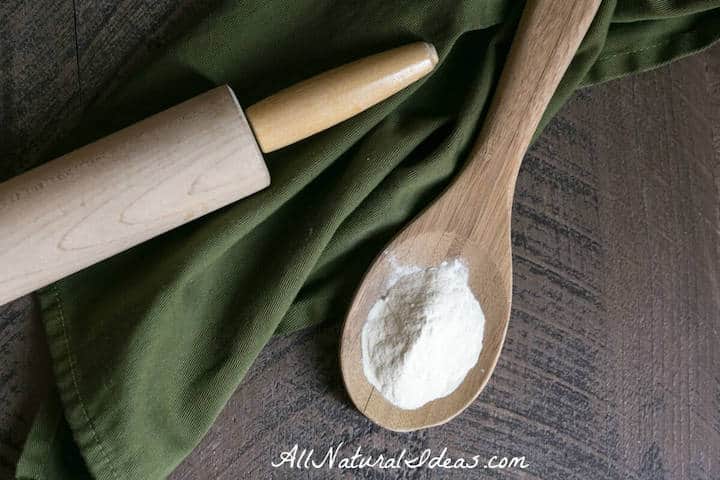What xanthan gum substitute can you use in gluten-free and low-carb recipes? Learn more about this common food additive and the available replacements for it.

Are you a natural food person who makes all your own recipes at home and rarely eats out? If not, you’re likely consuming xanthan gum which is a common additive to commercially prepared foods.
If you aren’t familiar with this food additive, here’s a quick overview:
- It’s safe for most people to consume it.
- The gum acts as a gel-like substance to thicken food.
- It’s common in gluten-free foods, especially baked goods.
- One health benefit is that it acts as a prebiotic. Prebiotics are like food for probiotics.
- Manufacturers make it by fermenting sugar and adding alcohol to the bacteria. They then dry it to form a powder.
- Those who extreme sensitivities to corn, wheat, soy or dairy should avoid it and use xanthan gum substitutes instead.
No time to read this entire article? You can easily jump to any topic in this article using the links in the The Table of Contents.
Table of contents
Is Xanthan Gum Natural?
Xanthan gum is not an all natural product that comes from a tree or the ground like a fruit, vegetable or grain. But it is a natural carbohydrate consisting of sugar, bacteria, and alcohol.
It was created in the 1960s by scientists. Back then, the gluten-free movement was virtually non-existent.
So why was it created?
Well, back in the mid-20th century, processed foods really started to take off. But food manufactures needed a way to thicken packaged foods. The food industry also needed a cheap way to separate oil from water.
Suppose you’re making your own salad dressing at home. What ingredients would you use? Maybe olive oil, balsamic vinegar, a spritz or two of lemon zest and a pinch of garlic.
Would you add xanthan gum to your homemade salad dressing? Probably not.
But in bottled salad dressing sold at supermarkets, xanthan gum helps mix the oil and other liquid ingredients. This is the reason why it’s also common in bottled and canned sauces.
It also prevents bottled foods from pouring out too quickly. So a xanthan gum replacement needs to provide the same gel-like consistency.
What’s it Made from?
In addition to bacteria, you need a sugar to make xanthan gum. The sugar can come from wheat, corn, or lactose (milk sugar). It can also be made from soybeans.
Technically, it’s not an emulsifier like egg yolks. However, it does give gluten-free dough the necessary elasticity and sticky consistency.
What Foods Contain It?
It’s not just in salad dressing, sauces, and gluten-free baked goods. There are a lot of other foods that contain it.
It’s often found in ice cream because it acts as a stabilizer. Adding it helps prevent ice crystals from forming provides the creamy texture.
Egg whites that come in a carton usually contain xanthan gum. And you’ll often find it in many other every day processed foods. It’s also common in toothpaste.
Is Xanthan Gum Safe?
For most people, it’s most likely harmless. However, only a limited number of studies have been done. The only time it has been shown to be a problem is when mice were fed really large amounts of it.
But if you have an allergy to corn, soy, wheat or dairy, it might be best to avoid it.
In a moment, we’ll cover some xanthan gum substitutes you can use at home. But there seems to be a few benefits when consuming it.
Benefits of Xanthan Gum
Are you familiar with prebiotics? If not, you’ve likely heard of probiotics. Probiotics are good bacteria. When you hear the term ‘probiotics’ it most often refers to the good-for-you bacteria in your intestinal tract.
Probiotics thrive when they have the right food to eat. Essentially, prebiotics are food that probiotics love to consume. They help keep the colonies of good bacteria healthy so they can fight off bad bacteria.
Xanthan gum acts as a prebiotic. That’s one advantage of eating certain foods with it. However, many products that have it are high in sugar. Therefore, any health benefit from the prebiotic fiber is cancelled out by the excess sugar.
Another possible benefit is that it’s a soluble fiber. Soluble fiber binds to water in your gut. This action creates a gel-like substance during digestion.
While this may sound a bit disgusting, there’s a big benefit to this. The gel in your gut helps slow down digestion. And when your digestion slows down, you have less cravings and less of a tendency to overeat.
There are other benefits of soluble fiber as well. A big one is it helps lower blood sugar and cholesterol levels. Soluble fiber helps pull out excess cholesterol from the blood.
So you may want to choose a xanthan gum replacement that also has these benefits.

Is Xanthan Gum Keto?
Because xanthan gum is a carbohydrate, you may not think it’s keto-friendly. But it is. Since it’s a soluble fiber, it has zero net carbs making it popular for low carb recipes.
So yes, it is keto. However, if you want to avoid it, most xanthan gum substitutes are also low in carbs.
Using it in Gluten-Free Baking
Gluten is the protein that gives wheat its stretchy structure. But many people are sensitive to gluten. Xanthan gum is a popular alternative for those who are sensitive or highly allergic to gluten.
Xanthan gum can be derived from wheat. So those with Celiac Disease or Allergies may need to avoid it. But the Celiac Foundation states that Authentic Foods is one brand that’s safe to have.
Using a Xanthan Gum Substitute
If you need a xanthan gum replacement, you can bake gluten-free goods at home with other ingredients. The items below are the most popular keto-friendly substitutes:
- glucomannan (aka Konjac flour)
- psyllium fiber
- chia seeds
- flax seeds
- gelatin
- agar agar
If you’ve never heard of glucomannan, it’s the fiber from the root of a wild yam-like plant that’s native to Southeast Asia. Like xanthan gum, it’s also a soluble fiber.
As a soluble fiber, glucomannan can be beneficial for those who are watching their blood sugar levels. That makes it a good xanthan gum replacement for those on keto. And it’s an ingredient used to make low carb shiratake noodles.
You can also use glucomannan in place of the high carb thickener cornstarch. Just one teaspoon of it equals about 10 teaspoons of cornstarch or two cups of wheat flour. You can also use the same amount of glucomannan as xanthan gum.
Have you heard of agar agar? It comes from a red species of seaweed. Basically, it’s like the vegetarian version of gelatin.
According to this vegan baking blog, agar agar has a neutral taste. Good to know if the thought of making gluten-free cookies that has a seaweedy taste sounds disgusting.
Anyway, the vegan baking blog adds that you can use it to make a vegan-friendly whipped cream fruit salad. You can even use it as a sub for corn syrup if you’re watching your net carbs.
Do you use xanthan gum in your recipes? Or a xanthan gum substitute? Leave a comment below to let us know.






